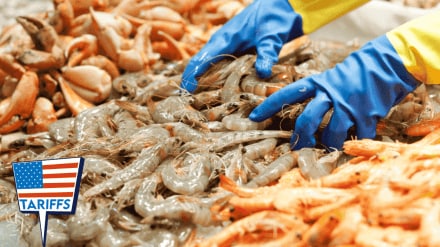imposition of tariff with exporters projecting 75% year-on-year fall in shipments in September.
While data of country-specific exports for September are yet to be officially available, decline in marine products exports to the US, which had 35% share, is expected to pull down overall shipment in FY26, exporters said.
“Shrimp exports are expected to fall in the second half of the current fiscal, after the US imposed effective duties of close to 60% on India’s shipment from August 27,” Ajay Srivastava, co-founder, GTRI, said.
According to GTRI, during April-August 2025-26, India’s exports of fish, crustaceans etc rose to $ 2.7 billion, an increase of over 15% on year while shipment to the US rose by only 2.7% to $ 859 million indicating slowdown in exports due to tariff.
Earlier on August 7, the US had declared a 25% tariff on Indian goods. Prior to the imposition of these tariffs, there were only 10% anti-dumping and countervailing duties imposed on India’s exports to the US.
India’s seafood exports, mostly frozen shrimp, were $ 7.45 billion or Rs 62,408 crore in FY25, with the United States having a share of 35% ($ 2.8 billion).
According to a quick estimate by the commerce ministry, during April-September 2025-26, marine products exports rose by 17% to $ 3.97 billion year on year.
Hit by tariffs by the US, India’s shrimp export volumes are expected to decline by 15% -18% in the current fiscal, rating firm Crisil Ratings has recently stated.
Industry officials said the seafood exports have been ‘hit hard’ as effective duties imposed by the US have been increased to 59.71% which includes countervailing (5.76%) and anti-dumping duties (3.96%) along with a 50% tariff announced for India by President Donald Trump.
The bulk of the country’s seafood exports to the US is ‘Vannamei Shrimp’. Ecuador had a 19% in the USA’s annual seafood import of $ 6 billion.
The tariff by the US has put Indian seafood at a major disadvantage compared to competitors like Ecuador (15%), Vietnam (20%), and Thailand (19%) tariff.
Indian seafood exporters are exploring alternative markets such as Australia, European Union (EU), southeast middle east regions to offset some of their losses, an official said.
“We are trying to find alternative markets including the EU, China, Thailand, Vietnam and Indonesia for boosting exports,” Alex K Ninan, vice president, Seafood Exporters Association of India, had earlier said. Although exporters acknowledge that developing a new export market for marine products would be time consuming.
Last month, the European Union approved 102 additional fishery units for shipments, the Marine Products Export Development Authority had stated.
This move is expected to help cushion the impact of US tariffs on India and help seafood exporters to make inroads into the European market.
